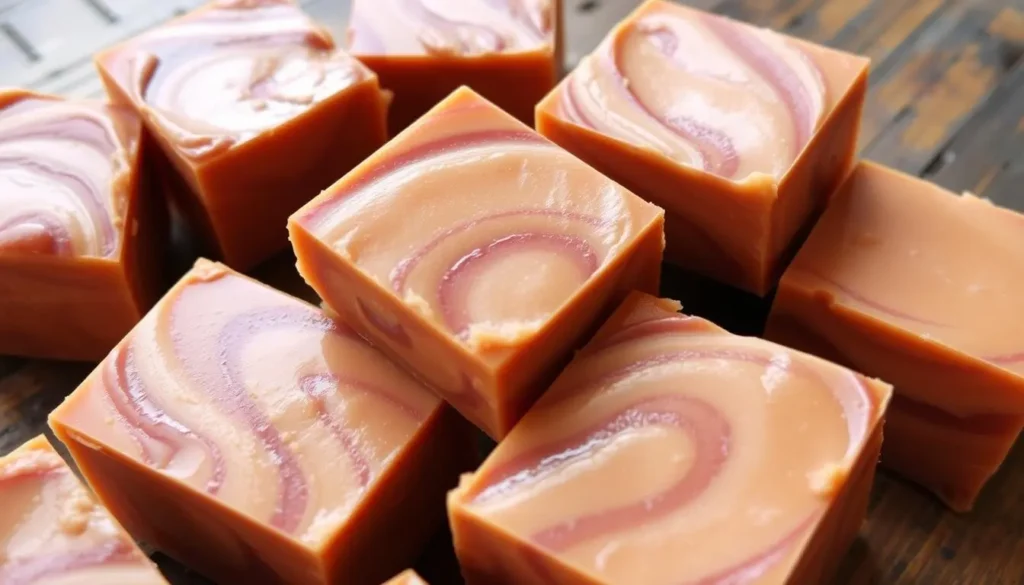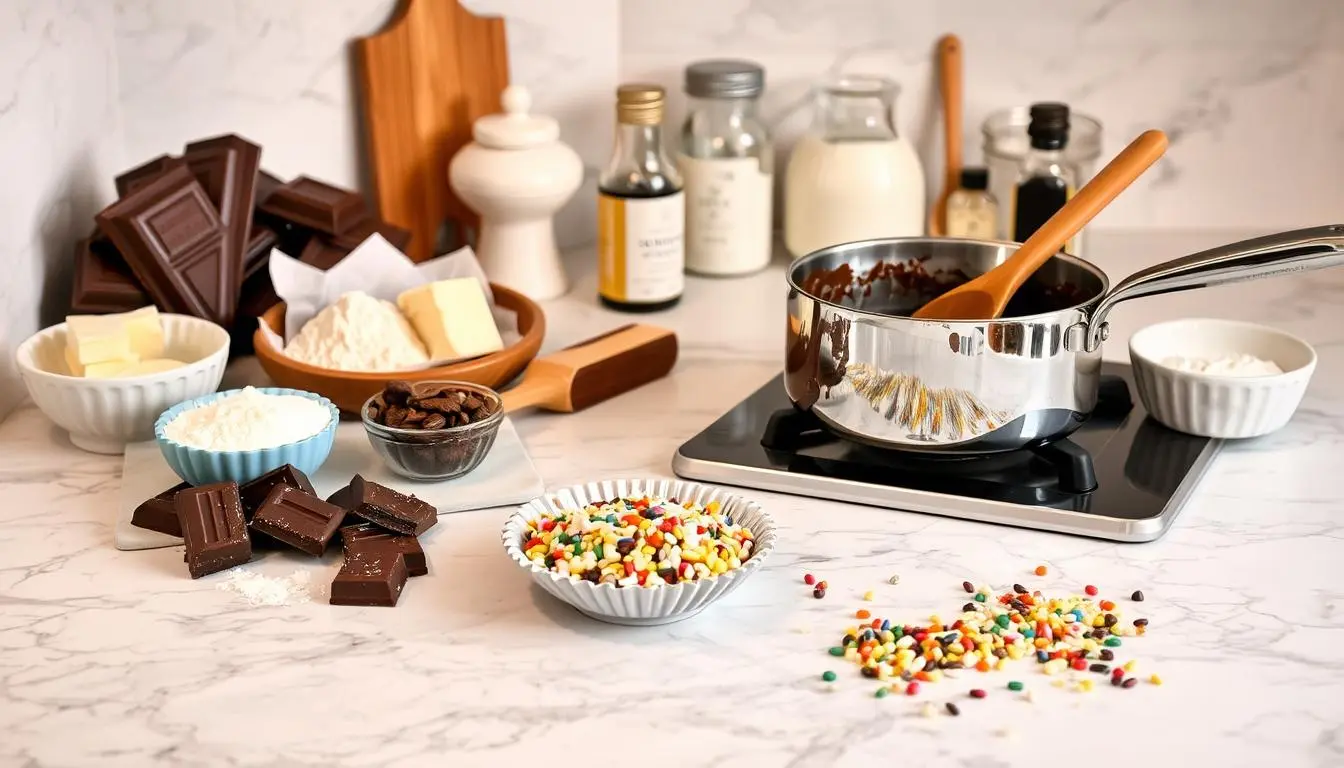What is the secret to good fudge? In this ultimate guide, we’ll reveal the techniques and tips you need to master the art of making smooth, melt-in-your-mouth fudge. Whether you’re a seasoned fudge maker or just starting, this guide covers everything you need to know to get it just right.
We’ll dive into the details of fudge making. You’ll learn about the key ingredients, advanced methods, and how to avoid mistakes. By the end, you’ll be ready to make fudge that wows everyone.
A cozy kitchen scene with a marble countertop, showcasing various ingredients for fudge making such as chocolate, butter, sugar, and vanilla extract neatly arranged. Include a saucepan on the stove with melting chocolate, a wooden spoon resting beside it, and a colorful array of toppings like nuts and sprinkles scattered around. Soft, warm lighting enhances the inviting atmosphere, with a hint of steam rising from the saucepan, conveying the rich, creamy texture of fudge in the air.
Let’s start this tasty adventure. We’ll share fudge making tips and fudge recipes to boost your baking skills.
Understanding the Science Behind Perfect Fudge
Making perfect fudge texture needs a deep understanding of science. It involves knowing the fudge cooking techniques and how sugar molecules work. Let’s explore the fascinating science of making fudge.
Crystallization Process Explained
The secret to perfect fudge texture is in sugar crystallization. When heated, sugar turns into a smooth liquid. But, the magic happens when it cools down.
During cooling, sugar molecules form tiny, uniform crystals. This gives fudge its creamy, melt-in-your-mouth feel.
Temperature Control Fundamentals
Temperature control is crucial in fudge-making. The cooking and cooling temperatures affect the texture. Keeping the right temperature prevents grainy crystals.
This ensures the fudge stays smooth and velvety.
Sugar Molecule Behavior
Sugar molecules play a key role in fudge-making. When heated, they break free from their structure. As they cool, they form new, uniform crystals.
This process is essential for achieving the right fudge texture. Knowing how sugar molecules behave is key to mastering fudge cooking techniques.

A close-up of rich, glossy fudge showcasing a smooth, velvety texture with swirls and glossy highlights, set against a rustic wooden surface; the fudge is cut into neat squares, some with softened edges, emphasizing its creamy consistency and decadent sheen.
Essential Ingredients for Classic Fudge Making
At the heart of any delicious fudge is a mix of key ingredients. Sugar adds a sweet, creamy taste, while butter makes it smooth and rich. Understanding these fudge ingredients is crucial for making the perfect treat.
Sugar is the base of fudge, giving it its texture and taste. You can use high-quality cane sugar or mix granulated and brown sugar for different flavors. Butter adds a luxurious feel and flavor, making the fudge even better.
| Ingredient | Function | Ideal Proportion |
|---|---|---|
| Sugar | Sweetener, Texture | 1-1.5 cups per batch |
| Butter | Richness, Mouthfeel | 4-6 tablespoons per batch |
| Cream or Milk | Creaminess, Smoothness | 1/4-1/2 cup per batch |
| Vanilla Extract | Flavor Enhancement | 1-2 teaspoons per batch |
Adding flavor extracts like vanilla or chocolate, nuts, or other mix-ins can make fudge even better. The secret to good fudge is finding the right mix of these ingredients. This way, each one adds its special touch to the fudge.
What Is the Secret to Good Fudge? Expert Insights Revealed
Making perfect fudge is all about science, technique, and timing. Seasoned confectioners have found the secrets to making great fudge. Now, we’re sharing these tips to help you improve your fudge making tips and fudge cooking techniques.
Precise Temperature Control
Getting the perfect fudge starts with careful temperature control. Fudge making is a precise process that balances sugar crystallization and heat. By controlling the temperature, you ensure the sugar forms the right crystals, making the fudge smooth and creamy.
Proper Beating Technique
Mastering the art of beating fudge is a hallmark of skilled confectioners. The right beating technique helps create tiny, uniform sugar crystals. This gives fudge its unique melt-in-your-mouth quality. The right amount of force and beating time can greatly affect the texture.
Timing Your Steps
Timing is crucial in every step of fudge making. From heating to cooling, every second matters. Knowing when to stop heating, start beating, and pour the fudge can make a huge difference.
By learning these expert tips, you’ll be able to make fudge that’s truly extraordinary. Discover the secrets to fudge making tips and fudge cooking techniques and take your homemade fudge to new levels of deliciousness.
Professional Equipment and Tools You’ll Need
Making delicious fudge is more than just the right ingredients. You also need the right tools and equipment. Professional fudge makers use specific kitchen essentials to make sure their fudge is perfect every time. Let’s look at the key items you’ll need for fudge making success.
- A high-quality candy thermometer is a must. It lets you check and control the temperature during cooking. This is key for the right texture and consistency.
- A heavy-bottomed saucepan or pot is important for even heat. It prevents scorching and keeps the temperature stable. This ensures your fudge recipes are perfect.
- A strong wooden spoon or silicone spatula is great for stirring and scraping the pan. This helps avoid crystals forming.
- An electric mixer or stand mixer with a paddle is essential. It’s used for beating the mixture to get a smooth, creamy texture.
- A baking pan or mold lined with parchment paper or a silicone mat is needed. It’s where you pour and set the fudge.
With these tools, you’ll be ready to make fudge that’s as good as the best shops. Invest in quality equipment. Your fudge making tips and fudge recipes will stand out.
Step-by-Step Fudge Making Process
Making perfect fudge is a delicate art. It needs a deep understanding of the science and careful steps. Follow this guide to become a fudge-making pro.
Preparation Phase
Start by getting all your ingredients and tools ready. Measure sugar, butter, milk, and flavorings accurately. Grease your baking pan or use parchment paper for easy fudge removal. Make sure you have a heavy saucepan, candy thermometer, and mixing spoon.
Cooking Phase
Now, heat up the stove. Mix sugar, butter, and milk in your saucepan, stirring constantly. Aim for a rolling boil and keep the temperature control tight. This ensures the right fudge texture.
Cooling and Setting Phase
- Take the saucepan off the heat and stir hard to form crystals.
- Pour the fudge into the pan and cool it at room temperature.
- After cooling, cut the fudge into squares and enjoy your hard work!
Learning fudge cooking techniques and the science behind it is key. With patience and practice, you’ll make delicious fudge recipes that everyone will love.
Common Fudge Making Mistakes to Avoid
Making perfect fudge is an art that requires care. Even a small mistake can ruin your fudge. Knowing the common mistakes helps you avoid them and make good fudge.
One big mistake is not controlling the temperature right. Fudge needs the sugar to crystallize at the right temperature. A small mistake can make the fudge grainy or soft. Use a good candy thermometer and watch the temperature closely.
Beating the fudge mixture is also important. If you don’t beat it enough or too hard, it can be dense or gritty. Learning to beat it just right is key to good fudge.
Timing is also key. If you don’t cool and set the fudge as the recipe says, it can be too sticky or dry. Always follow the cooling and setting times for the best fudge.
| Common Fudge Making Mistakes | Potential Issues |
|---|---|
| Inaccurate temperature control | Grainy or soft texture |
| Improper beating technique | Dense, gritty, or separated final product |
| Incorrect timing of cooling and setting | Sticky, gooey or crumbly, dry texture |
By avoiding these common mistakes, you can get better at making fudge. With patience and practice, you’ll make fudge that everyone will love. It will be smooth and creamy, perfect for sharing with friends and family.
Different Types of Fudge and Their Characteristics
Exploring the world of fudge, we find many tasty varieties. From traditional chocolate fudge to specialty flavored variants, there’s something for everyone. Each type offers a unique taste experience.
Traditional Chocolate Fudge
Chocolate fudge is a timeless favorite. It’s rich, creamy, and indulgent. Made with cocoa, sugar, and butter, it has a smooth texture that melts in your mouth.
Specialty Flavored Variants
Chocolate is loved, but there’s more to fudge. Fudge recipes now include flavors like peanut butter and mint. These new tastes offer exciting experiences for those who love to try new things.
Regional Fudge Styles
- Mackinac Island Fudge: Known for its silky texture and rich flavor, it comes from Michigan’s Mackinac Island.
- Vasona Fudge: From California, it’s famous for its smooth texture and creative flavors, often using local ingredients.
- Vermont Maple Fudge: Made in maple syrup country, it’s sweet and maple-infused, perfect for those who love sweet treats.
Whether you love chocolate or want to try new flavors, fudge has something for you. It’s a world of delicious possibilities waiting to be discovered.
You May Also Like:
- Delicious Chicken Pot Pie with Crescent Rolls: Easy Recipes 2024
- Easy Frozen Chicken Crock Pot Recipes for Dinner
- Why Cut Bologna Before Frying? Tips for Perfect Slices
- Can You Use Egg Whites in Burgers? | Cooking Tips
- Egg White Burger Buns Recipe: Healthy, Low-Fat, and High-Protein
Troubleshooting Fudge Texture Problems
Getting the perfect fudge texture can be tricky. But don’t worry, we’ve got you covered. This guide will help you fix common issues like grainy, soft, or hard fudge. You’ll learn how to make fudge that’s just right.
Grainy Fudge
Grainy fudge often comes from sugar not crystallizing right. To fix it, try these steps:
- Make sure your sugar ratio is correct.
- Cook the fudge to the right temperature, as the recipe says.
- Beat the fudge hard while it cools to make it smoother.
Soft and Gooey Fudge
Soft, gooey fudge usually means it’s not cooked enough or cooled enough. To make it firmer:
- Cook the mixture to 235-240°F (113-116°C).
- Let the fudge cool completely before cutting.
- Add a bit of corn syrup or stabilizers to help it set.
Hard and Brittle Fudge
Hard, brittle fudge often comes from overcooking or not beating enough. To soften it:
- Cook at a lower temperature or for less time.
- Beat the fudge hard for longer while it cools.
- Add a little cream or milk to make it softer.
Remember, fudge texture is all about balance. With a bit of practice and understanding fudge troubleshooting, you’ll make perfect fudge every time.
Storage Tips and Shelf Life Guidelines
Keeping your homemade fudge fresh and tasty is key. Learning how to store it right can make it last longer. Here are some tips to keep your fudge delicious for weeks.
Proper Packaging Methods
Storing fudge in an airtight container is crucial. Use plastic or glass containers with tight lids to keep it fresh. You can also wrap each piece in wax paper or plastic wrap before putting them in the container. This keeps them from drying out or getting bad smells.
Temperature Considerations
Fudge should be stored in a cool, steady temperature. Aim for 50°F to 70°F. Don’t let it get too hot or cold, as it can melt or get grainy. Keep it in a cool, dry spot like a pantry or fridge.
Freezing Instructions
- Wrap each fudge piece in plastic wrap or foil to stop freezer burn.
- Put the wrapped fudge in an airtight container or freezer bag, squeezing out air.
- Mark the container with the date and what’s inside, and freeze for up to 3 months.
- Thaw the fudge at room temperature when you’re ready to eat it.
By using these storage tips, you can enjoy your homemade fudge for months. Proper packaging, keeping the right temperature, and freezing correctly are the secrets to great-tasting fudge recipes.
Advanced Fudge Making Techniques
Fudge lovers looking to improve their skills will find lots to try. There’s more than just chocolate fudge out there. The world of fudge is full of flavors and textures to discover.
Layered fudge is a fun way to make fudge. It has different colors and tastes in each layer. Imagine a slice with chocolate, vanilla, and fruit fudge. Making it right takes great timing and temperature control.
For a unique taste, try adding nuts, dried fruits, or spices to your fudge. Mixing soft fudge with crunchy or chewy bits can make it even better.
Exploring innovative flavor combinations is exciting. You can mix classic flavors with new ones like salted caramel or chai-spiced fudge. It’s a great way to impress dessert lovers.
| Fudge Technique | Description | Skill Level |
|---|---|---|
| Layered Fudge | Fudge with distinct bands of contrasting colors and flavors | Advanced |
| Textured Fudge | Fudge with unexpected crunchy, chewy, or savory elements | Intermediate |
| Specialty Flavors | Fudge infused with unique, innovative flavor combinations | Advanced |
Whether you’re new or experienced, these techniques are a great way to dive deeper into fudge making. Don’t be afraid to try new things and explore bold flavors. It’s a fun way to make amazing fudge.
Adapting Recipes for Different Dietary Needs
Fudge lovers come from all walks of life, each with their own dietary needs. Whether you’re making vegan, sugar-free, or gluten-free fudge, classic fudge recipes can be tweaked. By knowing the roles of fudge ingredients and their substitutes, you can make sure everyone enjoys homemade fudge.
For vegan fudge, use coconut oil, almond milk, or oat milk instead of dairy. Choose maple syrup, agave nectar, or date paste for sweetness. To make gluten-free fudge, swap all-purpose flour for gluten-free or nut-based flours. Try sugar-free options with natural sweeteners like erythritol or monk fruit sweetener.
Adapting fudge recipes for different diets is all about finding the right balance. With a bit of creativity, you can enjoy fudge that fits your nutritional needs. Make homemade fudge that’s tailored to your taste and dietary requirements.
FAQs About What Is the Secret to Good Fudge?
What is the secret to good fudge?
Good fudge comes from precise temperature control and beating technique. Timing each step is also crucial. These elements help make smooth, creamy, and rich fudge.
What are the essential ingredients for classic fudge?
Classic fudge needs sugar, butter, cream or milk, and flavorings like vanilla or chocolate. The quality and mix of these ingredients affect the fudge’s texture and taste.
How do I avoid common fudge-making mistakes?
To avoid mistakes, check your temperature readings and don’t over-mix. Also, cool and set the fudge correctly. Knowing these tips can help you make perfect fudge every time.
What types of fudge are there, and how do they differ?
There’s a wide range of fudge, from traditional chocolate to specialty flavors. Each type has its own texture, taste, and making method.
How do I properly store homemade fudge?
To keep homemade fudge fresh, use the right packaging and store it at the correct temperature. Freezing is also a good way to preserve it for longer.

